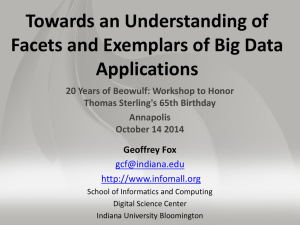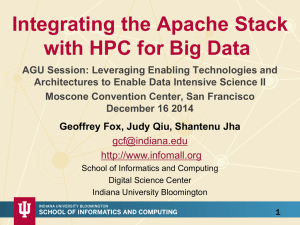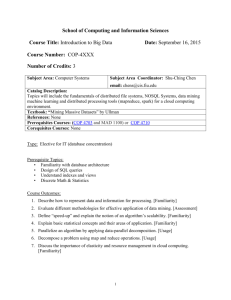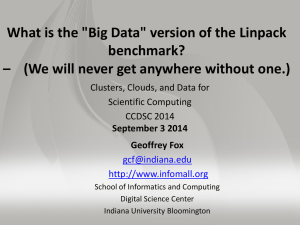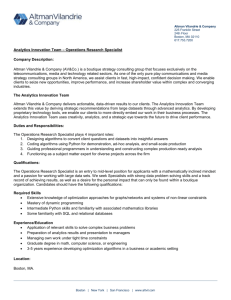Classification of Big Data Applications and
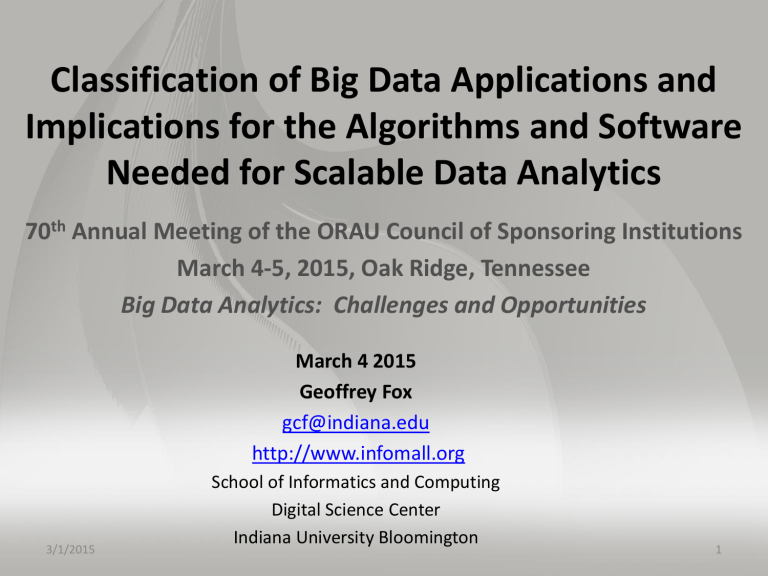
Classification of Big Data Applications and
Implications for the Algorithms and Software
Needed for Scalable Data Analytics
70 th Annual Meeting of the ORAU Council of Sponsoring Institutions
March 4-5, 2015, Oak Ridge, Tennessee
Big Data Analytics: Challenges and Opportunities
March 4 2015
Geoffrey Fox gcf@indiana.edu
http://www.infomall.org
School of Informatics and Computing
Digital Science Center
Indiana University Bloomington
3/1/2015 1
HPC and Data Analytics/Software
• Develop data analytics library SPIDAL (Scalable Parallel Interoperable Data
Analytics Library ) of similar quality to PETSc and ScaLAPACK which have been very influential in success of HPC for simulations
• Approach:
• 1) Analyze Big Data applications to identify analytics needed and generate benchmark applications and characteristics (Ogres with facets)
• 2) Analyze existing analytics libraries (in practice limit to some application domains and some general libraries Mahout, R. MLlib)
• 3) Analyze Big Data Software and identify software model HPC-ABDS (HPC –
Apache Big Data Stack) to allow interoperability (Cloud/HPC) and high
performance merging HPC and commodity cloud software
• 4) Identify range of big data computer architectures
• 5) Design or identify new or existing algorithms including parallel implementation
• Many more data scientists than computational scientists so HPC implications of data analytics could be influential on simulation software and hardware
• Develop Data Science Curricula
3/1/2015 2
IU Data Science Program
• Program managed by cross disciplinary Faculty in Data Science. Currently
Statistics and Informatics and Computing School but will expand scope to full campus
• A purely online 4-course Certificate in Data Science has been running since January 2014 (with 100 students so far)
– Most students are professionals taking courses in “free time”
• Masters in Data Science (10 courses) approved October 2014
– Online or Residential (Online masters is just $11,500 total)
– 80 students this semester and 150 applications for Fall 2015
• A campus wide Ph.D. Minor in Data Science has been approved.
• Exploring PhD in Data Science
• Courses labelled as “ Decision-maker ” and “ Technical ” paths where
McKinsey says an order of magnitude more (1.5 million by 2018) unmet job openings in Decision-maker track
• I teach big data courses; 70 undergraduates, 10 graduate students and
40 executive education enrolled this semester
3/1/2015
NIST Big Data Initiative
Led by Chaitin Baru, Bob Marcus,
Wo Chang
4
NBD-PWG (NIST Big Data Public Working
Group) Subgroups & Co-Chairs
• There were 5 Subgroups
– Note mainly industry
• Requirements and Use Cases Sub Group
– Geoffrey Fox, Indiana U.; Joe Paiva, VA; Tsegereda Beyene, Cisco
• Definitions and Taxonomies SG
– Nancy Grady, SAIC; Natasha Balac, SDSC; Eugene Luster, R2AD
• Reference Architecture Sub Group
– Orit Levin, Microsoft; James Ketner, AT&T; Don Krapohl, Augmented
Intelligence
• Security and Privacy Sub Group
– Arnab Roy, CSA/Fujitsu Nancy Landreville, U. MD Akhil Manchanda, GE
• Technology Roadmap Sub Group
– Carl Buffington, Vistronix; Dan McClary, Oracle; David Boyd, Data
Tactics
• See http://bigdatawg.nist.gov/usecases.php
• And http://bigdatawg.nist.gov/V1_output_docs.php
5
3/1/2015
Use Case Template
• 26 fields completed for 51 areas
• Government Operation: 4
• Commercial: 8
• Defense: 3
• Healthcare and Life Sciences:
10
• Deep Learning and Social
Media: 6
• The Ecosystem for Research:
4
• Astronomy and Physics: 5
• Earth, Environmental and
Polar Science: 10
• Energy: 1
6
51 Detailed Use Cases: Contributed July-September 2013
Covers goals, data features such as 3 V’s, software, hardware
• http://bigdatawg.nist.gov/usecases.php
26 Features for each use case
• https://bigdatacoursespring2014.appspot.com/course (Section 5)
Biased to science
• Government Operation(4): National Archives and Records Administration, Census Bureau
• Commercial(8): Finance in Cloud, Cloud Backup, Mendeley (Citations), Netflix, Web Search,
Digital Materials, Cargo shipping (as in UPS)
• Defense(3): Sensors, Image surveillance, Situation Assessment
• Healthcare and Life Sciences(10): Medical records, Graph and Probabilistic analysis,
Pathology, Bioimaging, Genomics, Epidemiology, People Activity models, Biodiversity
• Deep Learning and Social Media(6): Driving Car, Geolocate images/cameras, Twitter, Crowd
Sourcing, Network Science, NIST benchmark datasets
• The Ecosystem for Research(4): Metadata, Collaboration, Language Translation, Light source experiments
• Astronomy and Physics(5): Sky Surveys including comparison to simulation, Large Hadron
Collider at CERN, Belle Accelerator II in Japan
•
• Earth, Environmental and Polar Science(10): Radar Scattering in Atmosphere, Earthquake,
Ocean, Earth Observation, Ice sheet Radar scattering, Earth radar mapping, Climate simulation datasets, Atmospheric turbulence identification, Subsurface Biogeochemistry
(microbes to watersheds), AmeriFlux and FLUXNET gas sensors
Energy(1): Smart grid
7
Application
Example
Montage
NEKTAR
Replica-
Exchange
Climate
Prediction
(generation)
Climate
Prediction
(analysis)
SCOOP
Coupled
Fusion
Table 4: Characteristics of 6 Distributed Applications
Execution Unit Communication Coordination Execution Environment
Multiple sequential and parallel executable
Multiple concurrent parallel executables
Multiple seq. and parallel executables
Files
Stream based
Pub/sub
Multiple seq. & parallel executables
Multiple Executable
Multiple executable
Files and messages
Multiple seq. & parallel executables
Files and messages
Files and messages
Stream-based
Dataflow
(DAG)
Dataflow
Dataflow and events
Master-
Worker, events
Dataflow
Dataflow
Dataflow
Dynamic process creation, execution
Co-scheduling, data streaming, async. I/O
Decoupled coordination and messaging
@Home (BOINC)
Dynamics process creation, workflow execution
Preemptive scheduling, reservations
Co-scheduling, data streaming, async I/O
Part of Property Summary Table
3/1/2015 8
3/1/2015
Features and 2 Examples
9
51 Use Cases: What is Parallelism Over?
• People: either the users (but see below) or subjects of application and often both
• Decision makers like researchers or doctors (users of application)
• Items such as Images, EMR, Sequences below; observations or contents of online store
– Images or “Electronic Information nuggets”
– EMR : Electronic Medical Records (often similar to people parallelism)
– Protein or Gene Sequences ;
– Material properties, Manufactured Object specifications, etc., in custom dataset
– Modelled entities like vehicles and people
• Sensors – Internet of Things
• Events such as detected anomalies in telescope or credit card data or atmosphere
• (Complex) Nodes in RDF Graph
• Simple nodes as in a learning network
• Tweets , Blogs , Documents , Web Pages, etc.
– And characters/words in them
• Files or data to be backed up, moved or assigned metadata
• Particles / cells / mesh points as in parallel simulations
10
Features of 51 Use Cases I
• PP (26) “All” Pleasingly Parallel or Map Only
• MR (18) Classic MapReduce MR (add MRStat below for full count)
• MRStat (7 ) Simple version of MR where key computations are simple reduction as found in statistical averages such as histograms and averages
• MRIter (23) Iterative MapReduce or MPI (Spark, Twister)
• Graph (9) Complex graph data structure needed in analysis
• Fusion (11) Integrate diverse data to aid discovery/decision making; could involve sophisticated algorithms or could just be a portal
• Streaming (41) Some data comes in incrementally and is processed this way
• Classify (30) Classification: divide data into categories
• S/Q (12) Index, Search and Query
3/1/2015 11
Features of 51 Use Cases II
• CF (4) Collaborative Filtering for recommender engines
• LML (36) Local Machine Learning (Independent for each parallel entity) – application could have GML as well
• GML (23) Global Machine Learning: Deep Learning, Clustering, LDA,
PLSI, MDS,
– Large Scale Optimizations as in Variational Bayes, MCMC, Lifted Belief
Propagation, Stochastic Gradient Descent, L-BFGS, Levenberg-Marquardt . Can call EGO or Exascale Global Optimization with scalable parallel algorithm
• Workflow (51) Universal
• GIS (16) Geotagged data and often displayed in ESRI, Microsoft
Virtual Earth, Google Earth, GeoServer etc.
• HPC (5) Classic large-scale simulation of cosmos, materials, etc. generating (visualization) data
• Agent (2) Simulations of models of data-defined macroscopic entities represented as agents
3/1/2015 12
13 Image-based Use Cases
• 13-15 Military Sensor Data Analysis/ Intelligence PP, LML, GIS, MR
• 7:Pathology Imaging/ Digital Pathology: PP, LML, MR for search becoming terabyte 3D images, Global Classification
• 18&35: Computational Bioimaging (Light Sources): PP, LML Also materials
• 26: Large-scale Deep Learning: GML Stanford ran 10 million images and 11 billion parameters on a 64 GPU HPC; vision (drive car), speech, and Natural
Language Processing
• 27: Organizing large-scale, unstructured collections of photos: GML Fit position and camera direction to assemble 3D photo ensemble
• 36: Catalina Real-Time Transient Synoptic Sky Survey (CRTS): PP, LML followed by classification of events ( GML )
• 43: Radar Data Analysis for CReSIS Remote Sensing of Ice Sheets: PP, LML to identify glacier beds; GML for full ice-sheet
• 44: UAVSAR Data Processing, Data Product Delivery, and Data Services: PP to find slippage from radar images
• 45, 46: Analysis of Simulation visualizations: PP LML ?GML
find paths, classify orbits, classify patterns that signal earthquakes, instabilities, climate, turbulence
3/1/2015 13
Internet of Things and Streaming Apps
• It is projected that there will be 24 (Mobile Industry Group) to 50 (Cisco)
billion devices on the Internet by 2020.
• The cloud natural controller of and resource provider for the Internet of
Things.
• Smart phones/watches, Wearable devices (Smart People), “Intelligent
River” “Smart Homes and Grid” and “Ubiquitous Cities”, Robotics.
• Majority of use cases are streaming – experimental science gathers data in a stream – sometimes batched as in a field trip. Below is sample
• 10: Cargo Shipping Tracking as in UPS, Fedex PP GIS LML
• 13: Large Scale Geospatial Analysis and Visualization PP GIS LML
• 28: Truthy: Information diffusion research from Twitter Data PP MR for
Search, GML for community determination
• 39: Particle Physics: Analysis of LHC Large Hadron Collider Data: Discovery of Higgs particle PP Local Processing Global statistics
• 50: DOE-BER AmeriFlux and FLUXNET Networks PP GIS LML
• 51: Consumption forecasting in Smart Grids PP GIS LML
14
3/1/2015
Big Data Patterns – the Ogres
15
7 Computational Giants of
NRC Massive Data Analysis Report
http://www.nap.edu/catalog.php?record_id=18374
1) G1:
Basic Statistics e.g. MRStat
2) G2:
Generalized N-Body Problems
3) G3:
Graph-Theoretic Computations
4) G4:
Linear Algebraic Computations
5) G5:
Optimizations e.g. Linear Programming
6) G6:
Integration e.g. LDA and other GML
7) G7:
Alignment Problems e.g. BLAST
3/1/2015 16
HPC Benchmark Classics
•
Linpack or HPL: Parallel LU factorization for solution of linear equations
•
NPB version 1: Mainly classic HPC solver kernels
–
MG: Multigrid
–
CG: Conjugate Gradient
–
FT: Fast Fourier Transform
–
IS: Integer sort
–
EP: Embarrassingly Parallel
–
BT: Block Tridiagonal
–
SP: Scalar Pentadiagonal
–
LU: Lower-Upper symmetric Gauss Seidel
3/1/2015 17
13 Berkeley Dwarfs
1) Dense Linear Algebra
2) Sparse Linear Algebra
3) Spectral Methods
4) N-Body Methods
5) Structured Grids
6) Unstructured Grids
7) MapReduce
8) Combinational Logic
9) Graph Traversal
10) Dynamic Programming
11) Backtrack and
Branch-and-Bound
12) Graphical Models
13) Finite State Machines
First 6 of these correspond to
Colella’s original.
Monte Carlo dropped.
N-body methods are a subset of
Particle in Colella.
Note a little inconsistent in that
MapReduce is a programming model and spectral method is a numerical method.
Need multiple facets!
3/1/2015 18
3/1/2015
Facets of the Ogres
19
Big Data Ogres and their Facets
• Big Data Ogres are an attempt to characterize applications and algorithms with a set of general common features that are called Facets
• Originally derived from NIST collection of 51 use cases but refined with experience
• The 50 facets capture common characteristics (shared by several problems)which are inevitably multi-dimensional and often overlapping. Divided into 4 views
• One view of an Ogre is the overall problem architecture which is naturally related to the machine architecture needed to support data intensive application.
• The execution (computational) features view, describes issues such as I/O versus compute rates, iterative nature and regularity of computation and the classic V’s of
Big Data: defining problem size, rate of change, etc.
• The data source & style view includes facets specifying how the data is collected, stored and accessed. Has classic database characteristics
• Processing view has facets which describe types of processing steps including nature of algorithms and kernels e.g. Linear Programming, Learning, Maximum
Likelihood
• Instances of Ogres are particular big data problems and a set of Ogre instances that cover enough of the facets could form a comprehensive benchmark/mini-app set
• Ogres and their instances can be atomic or composite
Problem Architecture View of Ogres (Meta or MacroPatterns) i.
Pleasingly Parallel – as in BLAST, Protein docking, some (bio-)imagery including Local
Analytics or Machine Learning – ML or filtering pleasingly parallel, as in bio-imagery, radar images (pleasingly parallel but sophisticated local analytics) ii.
Classic MapReduce: Search, Index and Query and Classification algorithms like collaborative filtering (G1 for MRStat in Features, G7) iii.
Map-Collective: Iterative maps + communication dominated by “collective” operations as in reduction, broadcast, gather, scatter. Common datamining pattern iv.
Map-Point to Point: Iterative maps + communication dominated by many small point to point messages as in graph algorithms v.
Map-Streaming: Describes streaming, steering and assimilation problems vi.
Shared Memory: Some problems are asynchronous and are easier to parallelize on shared rather than distributed memory – see some graph algorithms vii.
SPMD: Single Program Multiple Data, common parallel programming feature
viii. BSP or Bulk Synchronous Processing: well-defined compute-communication phases ix.
Fusion: Knowledge discovery often involves fusion of multiple methods. x.
Dataflow: Important application features often occurring in composite Ogres xi.
Use Agents: as in epidemiology (swarm approaches) xii.
Workflow: All applications often involve orchestration (workflow) of multiple components
21
Hardware, Software, Applications
• In my old papers (especially book Parallel Computing
Works!), I discussed computing as multiple complex systems mapped into each other
Problem Numerical formulation Software Hardware
• Each of these 4 complex systems has an architecture that can be described in similar language
• One gets an easy programming model if architecture of problem matches that of Software
• One gets good performance if architecture of hardware matches that of software and problem
• So “MapReduce” can be used as architecture of software
(programming model) or “Numerical formulation of problem”
1/26/2015 22
(1) Map Only
Input map
Output
6 Forms of
MapReduce
(1) Map Only
Input
PP
Local Analytics map
(2) Classic
MapReduce
Input
MR
Basic Statistics map
(3) Iterative Map Reduce ( 4) Point to Point or or Map-Collective Map-Communication
Input Iterations map
Local reduce reduce
Iterative
Output
(2) Classic
MapReduce
Input map
(3) Iterative Map Reduce ( 4) Point to Point or or Map-Collective Map-Communication
Input Iterations map
(5) Map Streaming maps brokers
(6) Shared memory
Map Communicates
Shared Memory
Local
Map &
Communicate reduce reduce
1/26/2015
Graph
Graph
Streaming
Events
Shared Memory
23
Graph
8 Data Analysis Problem Architectures
1) Pleasingly Parallel PP or “map-only” in MapReduce
BLAST Analysis; Local Machine Learning
2A) Classic MapReduce MR , Map followed by reduction
High Energy Physics (HEP) Histograms; Web search; Recommender Engines
2B) Simple version of classic MapReduce MRStat
Final reduction is just simple statistics
3) Iterative MapReduce MRIter
Expectation maximization Clustering Linear Algebra, PageRank
4A) Map Point to Point Communication
Classic MPI; PDE Solvers and Particle Dynamics; Graph processing Graph
4B) GPU (Accelerator) enhanced 4A) – especially for deep learning
5) Map + Streaming + Communication
Images from Synchrotron sources; Telescopes; Internet of Things IoT
6) Shared memory allowing parallel threads which are tricky to program but lower latency
Difficult to parallelize asynchronous parallel Graph Algorithms 24
There are a lot of Big Data and HPC Software systems in 17 (21) layers
Build on – do not compete with the 293 HPC-ABDS systems
Kaleidoscope of (Apache) Big Data Stack (ABDS) and HPC Technologies
17) Workflow-Orchestration: ODE, ActiveBPEL, Airavata, Pegasus, Kepler, Swift, Taverna, Triana, Trident, BioKepler, Galaxy, IPython, Dryad,
Naiad, Oozie, Tez, Google FlumeJava, Crunch, Cascading, Scalding, e-Science Central, Azure Data Factory, Google Cloud Dataflow, NiFi (NSA)
Cross-
Cutting
Functions
1) Message and Data
Protocols:
Avro, Thrift,
Protobuf
2) Distributed
Coordination:
Zookeeper,
Giraffe,
JGroups
16) Application and Analytics: Mahout , MLlib , MLbase, DataFu, R, pbdR, Bioconductor, ImageJ, Scalapack, PetSc, Azure Machine Learning,
Google Prediction API, Google Translation API, mlpy, scikit-learn, PyBrain, CompLearn, Caffe, Torch, Theano, H2O, IBM Watson, Oracle PGX,
GraphLab, GraphX, IBM System G, GraphBuilder(Intel), TinkerPop, Google Fusion Tables, CINET, NWB, Elasticsearch
15B) Frameworks: Google App Engine, AppScale, Red Hat OpenShift, Heroku, Aerobatic, AWS Elastic Beanstalk, Azure, Cloud Foundry,
Pivotal, IBM BlueMix, Ninefold, Jelastic, Stackato, appfog, CloudBees, Engine Yard, CloudControl, dotCloud, Dokku, OSGi, HUBzero, OODT
15A) High level Programming: Kite, Hive, HCatalog, Tajo, Shark, Phoenix, Impala, MRQL, SAP HANA, HadoopDB, PolyBase, Presto, Google
Dremel, Google BigQuery, Amazon Redshift, Drill, Pig, Sawzall, Google Cloud DataFlow, Summingbird
14B) Streams: Storm, S4, Samza, Google MillWheel, Amazon Kinesis, LinkedIn Databus, Facebook Scribe/ODS, Azure Stream Analytics
14A) Basic Programming model and runtime , SPMD, MapReduce: Hadoop, Spark, Twister, Stratosphere (Apache Flink), Reef, Hama, Giraph,
Pregel, Pegasus
13) Inter process communication Collectives, point-to-point, publish-subscribe: Harp, MPI, Netty, ZeroMQ, ActiveMQ, RabbitMQ, QPid,
Kafka, Kestrel, JMS, AMQP, Stomp, MQTT, Azure Event Hubs, Amazon Lambda
Public Cloud: Amazon SNS, Google Pub Sub, Azure Queues
3) Security &
Privacy:
InCommon,
OpenStack
Keystone,
LDAP, Sentry,
Sqrrl
12) In-memory databases/caches: Gora (general object from NoSQL), Memcached, Redis (key value), Hazelcast, Ehcache, Infinispan
12) Object-relational mapping: Hibernate, OpenJPA, EclipseLink, DataNucleus, ODBC/JDBC
12) Extraction Tools: UIMA, Tika
11C) SQL(NewSQL): Oracle, DB2, SQL Server, SQLite, MySQL, PostgreSQL, SciDB, Apache Derby, Google Cloud SQL, Azure SQL, Amazon
RDS, rasdaman, BlinkDB, N1QL, Galera Cluster, Google F1, IBM dashDB
11B) NoSQL: HBase, Accumulo, Cassandra, Solandra, MongoDB, CouchDB, Lucene, Solr, Berkeley DB, Riak, Voldemort, Neo4J, Yarcdata,
Jena, Sesame, AllegroGraph, RYA, Espresso, Sqrrl, Facebook Tao, Google Megastore, Google Spanner, Titan:db, IBM Cloudant
Public Cloud: Azure Table, Amazon Dynamo, Google DataStore
4)
Monitoring:
Ambari,
Ganglia,
Nagios, Inca
11A) File management: iRODS, NetCDF, CDF, HDF, OPeNDAP, FITS, RCFile, ORC, Parquet
10) Data Transport: BitTorrent, HTTP, FTP, SSH, Globus Online (GridFTP), Flume, Sqoop
9) Cluster Resource Management : Mesos, Yarn, Helix, Llama, Celery, HTCondor, SGE, OpenPBS, Moab, Slurm, Torque, Google Omega,
Facebook Corona
8) File systems: HDFS, Swift, Cinder, Ceph, FUSE, Gluster, Lustre, GPFS, GFFS, Haystack, f4
Public Cloud: Amazon S3, Azure Blob, Google Cloud Storage
21 layers 7) Interoperability: Whirr, JClouds, OCCI, CDMI, Libcloud, TOSCA, Libvirt
6) DevOps: Docker, Puppet, Chef, Ansible, Boto, Cobbler, Xcat, Razor, CloudMesh, Juju, Foreman, OpenStack Heat, Rocks, Cisco Intelligent
293
Automation for Cloud, Ubuntu MaaS, Facebook Tupperware, AWS OpsWorks, OpenStack Ironic, Google Kubernetes, Buildstep, Gitreceive
Software
5) IaaS Management from HPC to hypervisors: Xen, KVM, Hyper-V, VirtualBox, OpenVZ, LXC, Linux-Vserver, VMware ESXi, vSphere,
3/1/2015 25
Packages
Networking: Google Cloud DNS, Amazon Route 53
1/26/2015 26
One View of Ogres has Facets that are micropatterns or Execution Features
i.
Performance Metrics; property found by benchmarking Ogre ii.
Flops per byte; memory or I/O iii.
Execution Environment; Core libraries needed: matrix-matrix/vector algebra, conjugate gradient, reduction, broadcast; Cloud, HPC etc.
iv.
Volume: property of an Ogre instance v.
Velocity: qualitative property of Ogre with value associated with instance vi.
Variety: important property especially of composite Ogres vii.
Veracity: important property of “mini-applications” but not kernels
viii. Communication Structure; Interconnect requirements; Is communication BSP,
Asynchronous, Pub-Sub, Collective, Point to Point? ix.
Is application (graph) static or dynamic? x.
Most applications consist of a set of interconnected entities; is this regular as a set of pixels or is it a complicated irregular graph? xi.
Are algorithms Iterative or not? xii.
Data Abstraction: key-value, pixel, graph(G3), vector, bags of words or items xiii. Are data points in metric or non-metric spaces? xiv. Is algorithm O(N 2 ) or O(N) (up to logs) for N points per iteration (G2)
3/1/2015 27
Data Source and Style View of Ogres I
i.
SQL NewSQL or NoSQL: NoSQL includes Document,
Column, Key-value, Graph, Triple store; NewSQL is SQL redone to exploit NoSQL performance ii. Other Enterprise data systems: 10 examples from NIST integrate
SQL/NoSQL
iii. Set of Files or Objects: as managed in iRODS and extremely common in scientific research
iv. File systems, Object, Blob and Data-parallel (HDFS) raw storage:
Separated from computing or colocated? HDFS v Lustre v. Openstack
Swift v. GPFS
v. Archive/Batched/Streaming: Streaming is incremental update of datasets with new algorithms to achieve real-time response (G7);
Before data gets to compute system, there is often an initial data gathering phase which is characterized by a block size and timing.
Block size varies from month (Remote Sensing, Seismic) to day
28
Data Source and Style View of Ogres II
vi. Shared/Dedicated/Transient/Permanent: qualitative property of data; Other characteristics are needed for permanent auxiliary/comparison datasets and these could be interdisciplinary, implying nontrivial data movement/replication
vii. Metadata/Provenance: Clear qualitative property but not for kernels as important aspect of data collection process
viii. Internet of Things: 24 to 50 Billion devices on Internet by 2020
ix. HPC simulations: generate major (visualization) output that often needs to be mined x.
Using GIS: Geographical Information Systems provide attractive access to geospatial data
Note 10 Bob Marcus (lead NIST effort) access examples illustrate this
3/1/2015 29
2. Perform real time analytics on data source streams and notify users when specified events occur
Streaming Data
Specify filter
Filter Identifying
Events
Fetch streamed
Data
Posted Data
Post Selected
Events
Identified Events
Streaming Data
Streaming Data Archive
Repository
Storm, Kafka, Hbase, Zookeeper
3/1/2015 30
5A. Perform interactive analytics on observational scientific data
Science Analysis Code,
Mahout, R
Grid or Many Task Software, Hadoop, Spark, Giraph, Pig …
Record Scientific Data in
3/1/2015
“field”
Data Storage: HDFS, Hbase, File Collection
Direct Transfer
Streaming Twitter data for
Social Networking
Transport batch of data to primary analysis data system
Local
Accumulate and initial computing
NIST examples include
LHC, Remote Sensing,
Astronomy and
Bioinformatics
31
Facets in Processing (run time) View of Ogres I
i.
Micro-benchmarks ogres that exercise simple features of hardware such as communication, disk I/O, CPU, memory performance
ii. Local Analytics executed on a single core or perhaps node
iii. Global Analytics requiring iterative programming models (G5,G6) across multiple nodes of a parallel system
iv. Optimization Methodology: overlapping categories i.
Nonlinear Optimization (G6) ii.
Machine Learning iii.
Maximum Likelihood or
2 minimizations iv.
Expectation Maximization (often Steepest descent) v.
Combinatorial Optimization vi.
Linear/Quadratic Programming (G5) vii. Dynamic Programming v.
Visualization is key application capability with algorithms like MDS useful but it itself part of “mini-app” or composite Ogre
32
Facets in Processing (run time) View of Ogres II
vii. Streaming divided into 5 categories depending on event size and synchronization and integration
– Set of independent events where precise time sequencing unimportant.
– Time series of connected small events where time ordering important.
– Set of independent large events where each event needs parallel processing with time sequencing not critical
– Set of connected large events where each event needs parallel processing with time sequencing critical.
– Stream of connected small or large events to be integrated in a complex way.
viii. Basic Statistics (G1): MRStat in NIST problem features ix.
Search/Query/Index: Classic database which is well studied (Baru, Rabl tutorial) x.
Recommender Engine: core to many e-commerce, media businesses; collaborative filtering key technology xi.
Classification: assigning items to categories based on many methods
– MapReduce good in Alignment, Basic statistics, S/Q/I, Recommender, Calssification
xii. Deep Learning of growing importance due to success in speech recognition etc.
xiii. Problem set up as a graph (G3) as opposed to vector, grid, bag of words etc.
3/1/2015 33 xiv. Using Linear Algebra Kernels: much machine learning uses linear algebra kernels
Data Source and Style View
14 13 12 11 10 9 8 7
Processing View
6 5 4 3 2 1
Pleasingly Parallel
Classic MapReduce
Map-Collective
Map Point-to-Point
Map Streaming
Shared Memory
Single Program Multiple Data
Bulk Synchronous Parallel
Fusion
Dataflow
Agents
Workflow
Problem
Architecture
View
10
9
8
7
6
5
4
Geospatial Information System
HPC Simulations
Internet of Things
Metadata/Provenance
Shared / Dedicated / Transient / Permanent
Archived/Batched/Streaming
3
2
1
HDFS/Lustre/GPFS
Files/Objects
Enterprise Data Model
SQL/NoSQL/NewSQL
4 Ogre
Views and
50 Facets
Execution View
1 2 3 4 5 6 7 8 9 10 11 12 13 14
9
10
11
7
8
12
1
2
3
4
5
6
3/1/2015
Benchmarks based on Ogres
35
Benchmarks/Mini-apps spanning Facets
• Look at NSF SPIDAL Project, NIST 51 use cases, Baru-Rabl review
• Catalog facets of benchmarks and choose entries to cover “all facets”
• Micro Benchmarks: SPEC, EnhancedDFSIO (HDFS), Terasort, Wordcount,
Grep, MPI, Basic Pub-Sub ….
• SQL and NoSQL Data systems, Search, Recommenders: TPC (-C to x–HS for
Hadoop), BigBench, Yahoo Cloud Serving, Berkeley Big Data, HiBench,
BigDataBench, Cloudsuite, Linkbench
– includes MapReduce cases Search, Bayes, Random Forests, Collaborative Filtering
• Spatial Query: select from image or earth data
• Alignment: Biology as in BLAST
• Streaming: Online classifiers, Cluster tweets, Robotics, Industrial Internet of
Things, Astronomy; BGBenchmark; choose to cover all 5 subclasses
• Pleasingly parallel (Local Analytics): as in initial steps of LHC, Pathology,
Bioimaging (differ in type of data analysis)
• Global Analytics: Outlier, Clustering, LDA, SVM, Deep Learning, MDS,
PageRank, Levenberg-Marquardt, Graph 500 entries
• Workflow and Composite (analytics on xSQL) linking above
3/1/2015
Parallel Data Analytics Issues
37
Remarks on Parallelism I
• Most use parallelism over items in data set
– Entities to cluster or map to Euclidean space
• Except deep learning (for image data sets)which has parallelism over pixel plane in neurons not over items in training set
– as need to look at small numbers of data items at a time in Stochastic Gradient
Descent SGD
– Need experiments to really test SGD – as no easy to use parallel implementations tests at scale NOT done
– Maybe got where they are as most work sequential
• Maximum Likelihood or
2 both lead to structure like
• Minimize sum
items=1 parameters for item i)
N
(Positive nonlinear function of unknown
• All solved iteratively with (clever) first or second order approximation to shift in objective function
– Sometimes steepest descent direction; sometimes Newton
– 11 billion deep learning parameters; Newton impossible
– Have classic Expectation Maximization structure
– Steepest descent shift is sum over shift calculated from each point
• SGD – take randomly a few hundred of items in data set and calculate shifts over these and move a tiny distance
– Classic method – take all (millions) of items in data set and move full distance 38
Remarks on Parallelism II
• Need to cover non vector semimetric and vector spaces for clustering and dimension reduction (N points in space)
• MDS Minimizes Stress
(X) =
i<j =1
N weight(i,j) (
(i, j) - d(X i
, X j
)) 2
• Semimetric spaces just have pairwise distances defined between points in space
(i, j)
• Vector spaces have Euclidean distance and scalar products
– Algorithms can be O(N) and these are best for clustering but for MDS O(N) methods may not be best as obvious objective function O(N 2 )
– Important new algorithms needed to define O(N) versions of current O(N 2 ) –
“must” work intuitively and shown in principle
• Note matrix solvers all use conjugate gradient – converges in 5-100 iterations – a big gain for matrix with a million rows. This removes factor of N in time complexity
• Ratio of #clusters to #points important; new ideas if ratio >~ 0.1
3/1/2015 39
Algorithm Challenges
• See NRC Massive Data Analysis report
• O(N) algorithms for O(N 2 ) problems
• Parallelizing Stochastic Gradient Descent
• Streaming data algorithms – balance and interplay between batch methods (most time consuming) and interpolative streaming methods
• Graph algorithms
• Machine Learning Community uses parameter servers;
Parallel Computing (MPI) would not recommend this?
– Is classic distributed model for “parameter service” better?
• Apply best of parallel computing – communication and load balancing – to Giraph/Hadoop/Spark
• Are data analytics sparse?; many cases are full matrices
• BTW Need Java Grande – Some C++ but Java most popular in
ABDS, with Python, Erlang, Go, Scala (compiles to JVM) …..
40
Lessons / Insights
• Proposed classification of Big Data applications and Benchmarks with features generalized as facets
• Data intensive algorithms do not have the well developed high
performance libraries familiar from HPC
• Global Machine Learning or (Exascale Global Optimization) particularly challenging
• Develop SPIDAL (Scalable Parallel Interoperable Data Analytics
Library)
– New algorithms and new high performance parallel implementations
• Challenges with O(N 2 ) problems
• Integrate (don’t compete) HPC with “Commodity Big data”
(Google to Amazon to Enterprise/Startup Data Analytics)
– i.e. improve Mahout; don’t compete with it
– Use Hadoop plug-ins rather than replacing Hadoop
• Enhanced Apache Big Data Stack HPC-ABDS has ~290 members with HPC opportunities at Resource management, Storage/Data,
Streaming, Programming, monitoring, workflow layers.
3/1/2015 41


